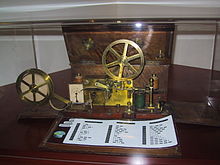
Back تاريخ التلغراف الكهربائي Arabic Електрически телеграф Bulgarian বৈদ্যুতিক টেলিগ্রাফ Bengali/Bangla Telègraf elèctric Catalan Elektrisk telegraf Danish Elektra telegrafo Esperanto Telegrafo elektriko Basque تلگراف برقی Persian Lennätin Finnish Télégraphie électrique French



Electrical telegraphy is a point-to-point text messaging system, primarily used from the 1840s until the late 20th century. It was the first electrical telecommunications system and the most widely used of a number of early messaging systems called telegraphs, that were devised to send text messages more quickly than physically carrying them.[1][2] Electrical telegraphy can be considered the first example of electrical engineering.[3]
Text telegraphy consisted of two or more geographically separated stations, called telegraph offices. The offices were connected by wires, usually supported overhead on utility poles. Many electrical telegraph systems were invented that operated in different ways, but the ones that became widespread fit into two broad categories. First are the needle telegraphs, in which electric current sent down the telegraph line produces electromagnetic force to move a needle-shaped pointer into position over a printed list. Early needle telegraph models used multiple needles, thus requiring multiple wires to be installed between stations. The first commercial needle telegraph system and the most widely used of its type was the Cooke and Wheatstone telegraph, invented in 1837. The second category are armature systems, in which the current activates a telegraph sounder that makes a click; communication on this type of system relies on sending clicks in coded rhythmic patterns. The archetype of this category was the Morse system and the code associated with it, both invented by Samuel Morse in 1838. In 1865, the Morse system became the standard for international communication, using a modified form of Morse's code that had been developed for German railways.
Electrical telegraphs were used by the emerging railway companies to provide signals for train control systems, minimizing the chances of trains colliding with each other.[4] This was built around the signalling block system in which signal boxes along the line communicate with neighbouring boxes by telegraphic sounding of single-stroke bells and three-position needle telegraph instruments.
In the 1840s, the electrical telegraph superseded optical telegraph systems such as semaphores, becoming the standard way to send urgent messages. By the latter half of the century, most developed nations had commercial telegraph networks with local telegraph offices in most cities and towns, allowing the public to send messages (called telegrams) addressed to any person in the country, for a fee.
Beginning in 1850, submarine telegraph cables allowed for the first rapid communication between continents. The introduction of nearly-instant message transmission across continents and oceans had widespread social and economic impacts. The electric telegraph led to Guglielmo Marconi's invention of wireless telegraphy which he began in 1894, the first means of radiowave telecommunication.[5]
In the early 20th century, manual operation of telegraph machines was slowly replaced by teleprinter networks. Increasing use of the telephone pushed telegraphy into only a few specialist uses; its use by the general public was mainly special occasion telegram greetings. The rise of the Internet and usage of email in the 1990s largely put an end to dedicated telegraphy networks.
- ^ Wenzlhuemer, Roland (August 2007). "The Development of Telegraphy, 1870–1900: A European Perspective on a World History Challenge" (PDF). History Compass. 5 (5): 1720–1742. doi:10.1111/j.1478-0542.2007.00461.x. ISSN 1478-0542.
- ^ Kieve 1973, p. 13.
- ^ Roberts, Steven. "Distant Writing: A History of the Telegraph Companies in Britain between 1838 and 1868: 2. Introduction".
Using these discoveries a number of inventors or rather 'adapters' appeared, taking this new knowledge, transforming it into useful ideas with commercial utility; the first of these 'products' was the use of electricity to transmit information between distant points, the electric telegraph.
- ^ Vanns, Michael A. (2012). Signalling in the Age of Steam. abc (2 ed.). Ian Allan. p. 16. ISBN 978-0-7110-3536-2.
- ^ Moss, Stephen (10 July 2013), "Final telegram to be sent. STOP", The Guardian: International Edition
© MMXXIII Rich X Search. We shall prevail. All rights reserved. Rich X Search